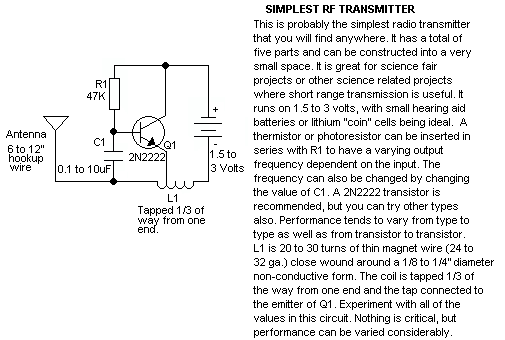
Simple RF Transmitter

This schematic represents a tone transmitter. When using sufficiently small resistor values, it generates a tone. A resistive microphone (such as a carbon microphone) can be placed in parallel with or replace the resistor, allowing modulation of the tone frequency with voice input. However, demodulating the signal may present challenges, making this circuit potentially unsuitable as a voice transmitter. It should be noted that the component in question should not replace the capacitor but rather be utilized like a resistor to control the capacitor. An individual reported constructing a similar circuit, which functioned effectively as an FM transmitter. The carrier signal was successfully received on an FM radio. While attempting to integrate an audio or voice signal, unintended tapping and knocking noises were detected, attributed to the physical movement of the circuit. The coil in the circuit was vibrating, thereby altering the frequency, which was then captured by the FM receiver as a frequency-modulated signal. It was suggested that for microphone functionality, the circuit could be affixed to a brick, with the coil attached to a window. This setup would allow the window to capture voice signals and mechanically transmit them through the circuit to the FM radio receiver. Although this method has not yet been tested, the individual expressed willingness to revisit the circuit upon receiving feedback on the post.
The tone transmitter schematic operates primarily on the principle of frequency modulation (FM). The circuit typically includes an oscillator, which generates a carrier wave at a specific frequency. The oscillator's frequency can be influenced by the resistance of the carbon microphone, which acts as a variable resistor. When voice signals are applied to the microphone, it changes the resistance, thereby modulating the frequency of the oscillating signal.
The circuit design may incorporate a coil, which serves as an inductor, and a capacitor, forming an LC circuit that determines the oscillation frequency. Proper selection of the inductor and capacitor values is crucial, as they dictate the frequency range of the transmission. The use of a carbon microphone allows for the conversion of sound waves into electrical signals, which can then be transmitted as frequency-modulated waves.
For practical implementation, ensuring a stable power supply is essential, as fluctuations can affect the signal quality. Additionally, the physical arrangement of components can influence performance. For instance, mounting the coil to a window can enhance sound capture by utilizing the window's surface to pick up vibrations from surrounding audio sources.
When considering demodulation, it is important to implement a suitable demodulator circuit to recover the original audio signal from the modulated carrier wave. Common demodulation techniques include envelope detection and phase-locked loops (PLLs), which can effectively extract the audio signal for playback or further processing.
Overall, the tone transmitter circuit offers a unique approach to audio transmission, leveraging simple components to achieve frequency modulation. Further experimentation and refinement may yield improved performance and practicality for voice transmission applications.This schematic is a tone transmitter. For sufficiently small values of the resistor, it outputs a tone, so having a resistive mic (carbon mic) in parallel with or in place of the resistor. would modulate the tone frequency with the voice. I`m not sure how you`d be able to demodulate it though, so this may not be the best circuit to use as a voice transmitter.
Sorry about my last post (and for bumping), it would NOT go in place of the capacator but as said before, it would be used like a resistor to control the capacitor. Hi All that is a very interesting cct. I built one almost exactly the same and it was shown as an FM transmitter. I. e. frequency modulated. Sure enough I could pick the carrier up on my FM radio about mid way on the scale. I was wondering how to put the audio/voice signal in when I noticed tapping and knocking noises coming up on the radio and a moved my physical circuit around !. The wound coil was vibrating and altering the frequency which was of cource then being picked up on the FM receiver as frequency modulated signal !
So for a microphone you could try glueing the circuit to a bit of brick and attaching the coil to a window. That way the window would pick up voice signals and mechanically feed them like a big microphone through the circuit into the FM radio receiver.
I havent tried this yet but if I see any replies to this post I will get my circuit out again as I still have it and a few other similar ones I was playing with for my data transmission project. 🔗 External reference
The tone transmitter schematic operates primarily on the principle of frequency modulation (FM). The circuit typically includes an oscillator, which generates a carrier wave at a specific frequency. The oscillator's frequency can be influenced by the resistance of the carbon microphone, which acts as a variable resistor. When voice signals are applied to the microphone, it changes the resistance, thereby modulating the frequency of the oscillating signal.
The circuit design may incorporate a coil, which serves as an inductor, and a capacitor, forming an LC circuit that determines the oscillation frequency. Proper selection of the inductor and capacitor values is crucial, as they dictate the frequency range of the transmission. The use of a carbon microphone allows for the conversion of sound waves into electrical signals, which can then be transmitted as frequency-modulated waves.
For practical implementation, ensuring a stable power supply is essential, as fluctuations can affect the signal quality. Additionally, the physical arrangement of components can influence performance. For instance, mounting the coil to a window can enhance sound capture by utilizing the window's surface to pick up vibrations from surrounding audio sources.
When considering demodulation, it is important to implement a suitable demodulator circuit to recover the original audio signal from the modulated carrier wave. Common demodulation techniques include envelope detection and phase-locked loops (PLLs), which can effectively extract the audio signal for playback or further processing.
Overall, the tone transmitter circuit offers a unique approach to audio transmission, leveraging simple components to achieve frequency modulation. Further experimentation and refinement may yield improved performance and practicality for voice transmission applications.This schematic is a tone transmitter. For sufficiently small values of the resistor, it outputs a tone, so having a resistive mic (carbon mic) in parallel with or in place of the resistor. would modulate the tone frequency with the voice. I`m not sure how you`d be able to demodulate it though, so this may not be the best circuit to use as a voice transmitter.
Sorry about my last post (and for bumping), it would NOT go in place of the capacator but as said before, it would be used like a resistor to control the capacitor. Hi All that is a very interesting cct. I built one almost exactly the same and it was shown as an FM transmitter. I. e. frequency modulated. Sure enough I could pick the carrier up on my FM radio about mid way on the scale. I was wondering how to put the audio/voice signal in when I noticed tapping and knocking noises coming up on the radio and a moved my physical circuit around !. The wound coil was vibrating and altering the frequency which was of cource then being picked up on the FM receiver as frequency modulated signal !
So for a microphone you could try glueing the circuit to a bit of brick and attaching the coil to a window. That way the window would pick up voice signals and mechanically feed them like a big microphone through the circuit into the FM radio receiver.
I havent tried this yet but if I see any replies to this post I will get my circuit out again as I still have it and a few other similar ones I was playing with for my data transmission project. 🔗 External reference





